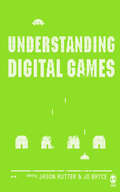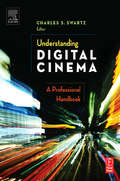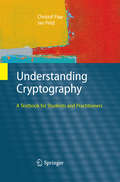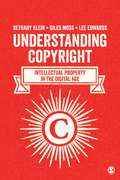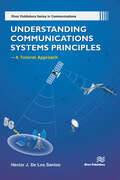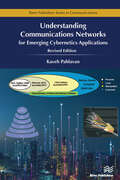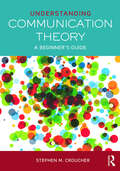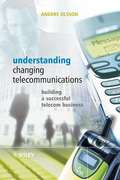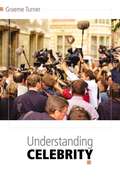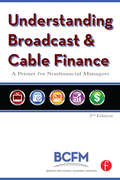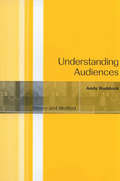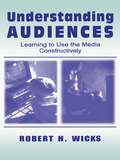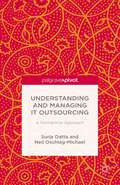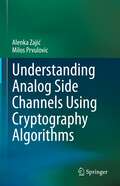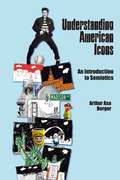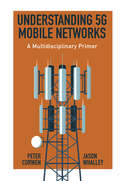- Table View
- List View
Understanding Digital Games
by Doctor Jason Rutter Dr Jo BryceThere are an increasing number of courses on digital games and gaming, following the rise in the popularity of games themselves. Amongst these practical courses, there are now theoretical courses appearing on gaming on media, film and cultural studies degree programmes. The aim of this book is to satisfy the need for a single accessible textbook which offers a broad introductions to the range of literatures and approaches currently contributing to digital game research. Each of the chapters will outline key theoretical perspectives, theorists and literatures to demonstrate their relevance to, and use in, the study of digital games.
Understanding Digital Cinema: A Professional Handbook
by Charles S. SwartzUNDERSTANDING DIGITAL CINEMA: A PROFESSIONAL HANDBOOK is a comprehensive resource on all aspects of finishing, distributing and displaying film digitally. For technical professionals as well as non-technical decision-makers, the book is a detailed exploration of every component of the process, from mastering to theater management. * An overview of digital cinema system requirements* Post production work flow* Color in digital cinema* The digital cinema mastering process* Fundamentals of compression * Security* Basics of audio * Digital distribution* Digital projection technology* Theater systems* The international perspective: Views from Europe, Asia and Latin America* A realistic assessment of the future of digital cinemaWith contributions by:Richard Crudo, President, American Society of CinematographersLeon Silverman, Executive Vice President, Laser Pacific Media CorporationCharles Poynton, Color ScientistChris Carey, Senior Vice President, Studio New Technology, The Walt Disney StudiosBob Lambert, Corporate Senior Vice President New Technology & New Media,The Walt Disney CompanyBill Kinder, Pixar Animation StudiosGlenn Kennel, DLP CinemaPeter Symes, Manager, Advanced Technology, Thomson Broadcast & Media SolutionsRobert Schumann, President, Cinea, Inc., A Subsidiary of Dolby LabsDavid Gray, Vice President, Production Services, Dolby Laboratories, Inc.Darcy Antonellis, Executive Vice President, Distribution and Technology OperationsWarner Bros. Technical Operations Inc. and Senior Vice President, Worldwide Anti-Piracy Operations Warner Bros. Entertainment Inc.Matt Cowan, Principal and Founder, Entertainment Technology ConsultantsLoren Nielsen, Principal and Founder, Entertainment Technology ConsultantsMichael Karagosian, Partner, Karagosian MacCalla Partners (KMP)Peter Wilson, Vice President, Display Technologies, Snell and Wilcox Ltd.Patrick Von Sychowski, Senior Analyst, Screen DigestWendy Aylsworth, Vice President of Technology, Warner Bros. Technical Operations Inc.
Understanding Digital Cinema: A Professional Handbook
by Charles S. SwartzUNDERSTANDING DIGITAL CINEMA: A PROFESSIONAL HANDBOOK is a comprehensive resource on all aspects of finishing, distributing and displaying film digitally. For technical professionals as well as non-technical decision-makers, the book is a detailed exploration of every component of the process, from mastering to theater management. * An overview of digital cinema system requirements* Post production work flow* Color in digital cinema* The digital cinema mastering process* Fundamentals of compression * Security* Basics of audio * Digital distribution* Digital projection technology* Theater systems* The international perspective: Views from Europe, Asia and Latin America* A realistic assessment of the future of digital cinemaWith contributions by:Richard Crudo, President, American Society of CinematographersLeon Silverman, Executive Vice President, Laser Pacific Media CorporationCharles Poynton, Color ScientistChris Carey, Senior Vice President, Studio New Technology, The Walt Disney StudiosBob Lambert, Corporate Senior Vice President New Technology & New Media,The Walt Disney CompanyBill Kinder, Pixar Animation StudiosGlenn Kennel, DLP CinemaPeter Symes, Manager, Advanced Technology, Thomson Broadcast & Media SolutionsRobert Schumann, President, Cinea, Inc., A Subsidiary of Dolby LabsDavid Gray, Vice President, Production Services, Dolby Laboratories, Inc.Darcy Antonellis, Executive Vice President, Distribution and Technology OperationsWarner Bros. Technical Operations Inc. and Senior Vice President, Worldwide Anti-Piracy Operations Warner Bros. Entertainment Inc.Matt Cowan, Principal and Founder, Entertainment Technology ConsultantsLoren Nielsen, Principal and Founder, Entertainment Technology ConsultantsMichael Karagosian, Partner, Karagosian MacCalla Partners (KMP)Peter Wilson, Vice President, Display Technologies, Snell and Wilcox Ltd.Patrick Von Sychowski, Senior Analyst, Screen DigestWendy Aylsworth, Vice President of Technology, Warner Bros. Technical Operations Inc.
Understanding Cryptography: A Textbook for Students and Practitioners
by Christof Paar Jan PelzlCryptography is now ubiquitous – moving beyond the traditional environments, such as government communications and banking systems, we see cryptographic techniques realized in Web browsers, e-mail programs, cell phones, manufacturing systems, embedded software, smart buildings, cars, and even medical implants. Today's designers need a comprehensive understanding of applied cryptography. After an introduction to cryptography and data security, the authors explain the main techniques in modern cryptography, with chapters addressing stream ciphers, the Data Encryption Standard (DES) and 3DES, the Advanced Encryption Standard (AES), block ciphers, the RSA cryptosystem, public-key cryptosystems based on the discrete logarithm problem, elliptic-curve cryptography (ECC), digital signatures, hash functions, Message Authentication Codes (MACs), and methods for key establishment, including certificates and public-key infrastructure (PKI). Throughout the book, the authors focus on communicating the essentials and keeping the mathematics to a minimum, and they move quickly from explaining the foundations to describing practical implementations, including recent topics such as lightweight ciphers for RFIDs and mobile devices, and current key-length recommendations. The authors have considerable experience teaching applied cryptography to engineering and computer science students and to professionals, and they make extensive use of examples, problems, and chapter reviews, while the book’s website offers slides, projects and links to further resources. This is a suitable textbook for graduate and advanced undergraduate courses and also for self-study by engineers.
Understanding Copyright: Intellectual Property in the Digital Age
by Giles Moss Lee Edwards Bethany KleinDigital technology has forever changed the way media is created, accessed, shared and regulated, raising serious questions about copyright for artists and fans, media companies and internet intermediaries, activists and governments. Taking a rounded view of the debates that have emerged over copyright in the digital age, this book: Looks across a broad range of industries including music, television and film to consider issues of media power and policy. Features engaging examples that have taken centre stage in the copyright debate, including high profile legal cases against Napster and The Pirate Bay, anti-piracy campaigns, the Creative Commons movement, and public protests against the expansion of copyright enforcement. Considers both the dominant voices, such as industry associations, and those who struggle to be heard, including ordinary media users, drawing on important studies into copyright from around the world. Offering media students and scholars a comprehensive overview of the contemporary issues surrounding intellectual property through the struggle over copyright, Understanding Copyright explores why disagreement is rife and how the policymaking process might accommodate a wider range of views.
Understanding Communications Systems Principles—A Tutorial Approach
by Héctor J. SantosWireless communications and sensing systems are nowadays ubiquitous; cell phones and automotive radars typifying two of the most familiar examples. This book introduces the field by addressing its fundamental principles, proceeding from its very beginnings, up to today's emerging technologies related to the fifth-generation wireless systems (5G), Multi-Input Multiple Output (MIMO) connectivity, and Aerospace/Electronic Warfare Radar. The tone is tutorial. Problems are included at the end of each chapter to facilitate the understanding and assimilation of the material to electrical engineering undergraduate/graduate students and beginning and non-specialist professionals. Free temporary access to Keysight's SystemVue system simulation is provided to further enhance reader learning through hands-on tutorial exercises.Chapter 1 introduces wireless communications and sensing and in particular how curiosity-driven scientific research led to the foundation of the field. Chapter 2 presents a brief introduction to the building blocks that make up wireless systems. Chapter 3 focuses on developing an understanding of the performance parameters that characterize a wireless system. Chapter 4 deals with circuit topologies for modulation and detection. In chapter 5 we cover the fundamental transmitter and receiver systems architectures that enable the transmission of information at precise frequencies and their reception from among a rather large multitude of other signals present in space. Chapter 6 introduces 5G, its motivation, and its development and adoption challenges for providing unprecedented levels of highest speed wireless connectivity. Chapter 7 takes on the topic of MIMO, its justification and its various architectures. Chapter 8 addresses the topic of aerospace/electronic warfare radar and finally Chapter 9 presents three Tutorials utilizing the SystemVue simulation tool.
Understanding Communications Systems Principles—A Tutorial Approach
by Héctor J. SantosWireless communications and sensing systems are nowadays ubiquitous; cell phones and automotive radars typifying two of the most familiar examples. This book introduces the field by addressing its fundamental principles, proceeding from its very beginnings, up to today's emerging technologies related to the fifth-generation wireless systems (5G), Multi-Input Multiple Output (MIMO) connectivity, and Aerospace/Electronic Warfare Radar. The tone is tutorial. Problems are included at the end of each chapter to facilitate the understanding and assimilation of the material to electrical engineering undergraduate/graduate students and beginning and non-specialist professionals. Free temporary access to Keysight's SystemVue system simulation is provided to further enhance reader learning through hands-on tutorial exercises.Chapter 1 introduces wireless communications and sensing and in particular how curiosity-driven scientific research led to the foundation of the field. Chapter 2 presents a brief introduction to the building blocks that make up wireless systems. Chapter 3 focuses on developing an understanding of the performance parameters that characterize a wireless system. Chapter 4 deals with circuit topologies for modulation and detection. In chapter 5 we cover the fundamental transmitter and receiver systems architectures that enable the transmission of information at precise frequencies and their reception from among a rather large multitude of other signals present in space. Chapter 6 introduces 5G, its motivation, and its development and adoption challenges for providing unprecedented levels of highest speed wireless connectivity. Chapter 7 takes on the topic of MIMO, its justification and its various architectures. Chapter 8 addresses the topic of aerospace/electronic warfare radar and finally Chapter 9 presents three Tutorials utilizing the SystemVue simulation tool.
Understanding Communications Networks – for Emerging Cybernetics Applications
by Kaveh PahlavanInformation networking has emerged as a multidisciplinary diversified area of research over the past few decades. From traditional wired telephony to cellular voice telephony and from wired access to wireless access to the Internet, information networks have profoundly impacted our lifestyles as they have undergone enormous growth. To understand this technology, students need to learn several disciplines and develop an intuitive feeling of how they interact with one another. To achieve this goal, the book describes important networking standards, classifying their underlying technologies in a logical manner and gives detailed examples of successful applications.The emergence of wireless access and dominance of the Ethernet in LAN technologies has shifted the innovations in networking towards the physical layer and characteristics of the medium. This book pays attention to the physical layer while we provide fundamentals of information networking technologies which are used in wired and wireless networks designed for local and wide area operations. The book provides a comprehensive treatment of the wired IEEE802.3 Ethernet, and Internet as well as ITU cellular 2G-6G wireless networks, IEEE 802.11 for Wi-Fi, and IEEE 802.15 for Bluetooth, ZigBee and ultra-wideband (UWB) technologies. The novelty of the book is that it places emphasis on physical communications issues related to formation and transmission of packets and characteristics of the medium for transmission in variety of networks.Material presented in the book will be beneficial for students of Electrical and Computer Engineering, Computer Science, Robotics Engineering, Biomedical Engineering, or other disciplines who are interested in integration of navigation into their multi-disciplinary projects. The book provides examples with supporting MATLAB codes and hands-on projects throughout to improve the ability of the readers to understand and implement variety of algorithms.
Understanding Communications Networks – for Emerging Cybernetics Applications
by Kaveh PahlavanInformation networking has emerged as a multidisciplinary diversified area of research over the past few decades. From traditional wired telephony to cellular voice telephony and from wired access to wireless access to the Internet, information networks have profoundly impacted our lifestyles as they have undergone enormous growth. To understand this technology, students need to learn several disciplines and develop an intuitive feeling of how they interact with one another. To achieve this goal, the book describes important networking standards, classifying their underlying technologies in a logical manner and gives detailed examples of successful applications.The emergence of wireless access and dominance of the Ethernet in LAN technologies has shifted the innovations in networking towards the physical layer and characteristics of the medium. This book pays attention to the physical layer while we provide fundamentals of information networking technologies which are used in wired and wireless networks designed for local and wide area operations. The book provides a comprehensive treatment of the wired IEEE802.3 Ethernet, and Internet as well as ITU cellular 2G-6G wireless networks, IEEE 802.11 for Wi-Fi, and IEEE 802.15 for Bluetooth, ZigBee and ultra-wideband (UWB) technologies. The novelty of the book is that it places emphasis on physical communications issues related to formation and transmission of packets and characteristics of the medium for transmission in variety of networks.Material presented in the book will be beneficial for students of Electrical and Computer Engineering, Computer Science, Robotics Engineering, Biomedical Engineering, or other disciplines who are interested in integration of navigation into their multi-disciplinary projects. The book provides examples with supporting MATLAB codes and hands-on projects throughout to improve the ability of the readers to understand and implement variety of algorithms.
Understanding Communication Theory: A Beginner's Guide
by Stephen M. CroucherThis book offers students a comprehensive, theoretical, and practical guide to communication theory. Croucher defines the various perspectives on communication theory—the social scientific, interpretive, and critical approaches—and then takes on the theories themselves, with topics including interpersonal communication, organizational communication, intercultural communication, persuasion, critical and rhetorical theory and other key concepts. Each theory chapter includes a sample undergraduate-written paper that applies the described theory, along with edits and commentary by Croucher, giving students an insider’s glimpse of the way communication theory can be written about and applied in the classroom and in real life. Featuring exercises, case studies and keywords that illustrate and fully explain the various communication theories, Understanding Communication Theory gives students all the tools they need to understand and apply prominent communication theories.
Understanding Communication Theory: A Beginner's Guide
by Stephen M. CroucherThis book offers students a comprehensive, theoretical, and practical guide to communication theory. Croucher defines the various perspectives on communication theory—the social scientific, interpretive, and critical approaches—and then takes on the theories themselves, with topics including interpersonal communication, organizational communication, intercultural communication, persuasion, critical and rhetorical theory and other key concepts. Each theory chapter includes a sample undergraduate-written paper that applies the described theory, along with edits and commentary by Croucher, giving students an insider’s glimpse of the way communication theory can be written about and applied in the classroom and in real life. Featuring exercises, case studies and keywords that illustrate and fully explain the various communication theories, Understanding Communication Theory gives students all the tools they need to understand and apply prominent communication theories.
Understanding Changing Telecommunications: Building a Successful Telecom Business
by Anders OlssonThe field of telecommunications is becoming ever more complex. In order to manage the new Telecom industry it is necessary not only to understand its 3 main components, namely the end users, the technology and networks, and the business aspects, but also their vital inter-relationships. Complexity leads to uncertainty, and one effect of uncertainty is for people to underestimate the complexity of the business and the technology. This book takes a holistic approach to the subject and can be used as a tool for decreasing this uncertainty. During 2000 many operators paid extremely high sums of money for 3G licenses in a number of European countries, supposing a potential corresponding and balancing revenue from mobile services in the new frequency band. Obviously today the licenses are questionable. Consequently, suppliers and operators were forced to reduce their international work force. What are the underlying reasons? Since the true rate and level of development was hardly foreseen by anyone, the picture is complex, including factors such as psychology and belief in a new economy. It is immediately clear that the end user impact has been severely under-estimated. It is also clear that the expected development has and is happening, with more speed than expected, and continues to be complemented with solutions such as wireless LANs. This book treats the paradigm shift from a number of angles: user needs and demands, deregulation of telecom and the convergence between telecommunications, data communications and the media industry, the service plan, service implementation, QoS, and Security. Understanding Changing Telecommunications focuses on the overall principles and context of the new telecommunications world rather than on high-level technical descriptions in order to aid the understanding and development of the next generation of telecom networks. e.g. multimedia over IP and 3G. Discusses the development of telecommunications up until 2005 Provides a holistic view of the world of telecommunications Covers three main areas: End-users, Technologies and Networks, and Telecom Business, and their vital inter-relationships Offers support and advice for those needing to implement business plans Essential reading for staff with operators and providers involved in the telecom networks, especially management, planning and design, development, integration and training, as well as Business analysts and investors keen to understand the current state of the Telecom industry.
Understanding Celebrity (PDF)
by Professor Graeme Turner`Graeme Turner is one of the leading figures in cultural studies today. When his gaze turns to celebrity, the result is a readable and compelling account of this most perplexing and infuriating of modern phenomena. Read on!' - Toby Miller, New York University We cannot escape celebrity culture: it is everywhere. So just what is the cultural function of celebrity? This is the first comprehensive overview of the production and consumption of celebrity from within cultural and media studies. The pervasive influence of contemporary celebrity, and the cultures it produces, has been widely noticed. Earlier studies, though, have tended to focus on the consumption of celebrity or on particular locations of celebrity - Hollywood, or the sports industries for instance. This book presents a broad survey across all media as well as a new synthesis of theoretical positions, that will be welcomed by all students of media and cultural studies. Among its attributes are the following: -It provides an overview and evaluation of the key debates surrounding the definition of celebrity, its history, and its social and cultural function -It examines the 'celebrity industries’: the PR and publicity structures that manufacture celebrity -It looks at the cultural processes through which celebrity is consumed -It draws examples from the full range of contemporary media - film, television, newspapers, magazines and the web
Understanding Broadcast and Cable Finance: A Primer for the Non-Financial Manager
by Broadcast Cable Financial ManaFrom on-air talent contracts and FCC regulations to syndicated program amortization to music licensing fees, electronic media deal with financial principles and jargon that are unique to American business. Understanding Broadcast and Cable Finance helps explain all the financial complexities of a modern electronic media enterprise. Whether you are a news director, sales manager, engineer or any other non-accounting professional that has a stake in the success of your company, this book will bring you up-to-speed on the essentials of financial management for broadcasting and cable.
Understanding Broadcast and Cable Finance: A Primer for the Non-Financial Manager
by Broadcast Cable Financial ManaFrom on-air talent contracts and FCC regulations to syndicated program amortization to music licensing fees, electronic media deal with financial principles and jargon that are unique to American business. Understanding Broadcast and Cable Finance helps explain all the financial complexities of a modern electronic media enterprise. Whether you are a news director, sales manager, engineer or any other non-accounting professional that has a stake in the success of your company, this book will bring you up-to-speed on the essentials of financial management for broadcasting and cable.
Understanding Audiences: Theory and Method
by Andy RuddockThe history of audience research tells us that the relationship between the media and viewers, readers and listeners is complex and requires multiple methods of analysis. In Understanding Audiences, Andy Ruddock introduces students to the range of quantitative and qualitative methods and invites his readers to consider the merits of both. Understanding Audiences: demonstrates how - practically - to investigate media power; places audience research - from early mass communication models to cultural studies approaches - in their historical and epistemological context; explores the relationship between theory and method; concludes with a consideration of the long-running debate on media effects; includes exercises which invite readers to engage with the practical difficulties of conducting social research.
Understanding Audiences: Theory and Method
by Dr Andy RuddockThe history of audience research tells us that the relationship between the media and viewers, readers and listeners is complex and requires multiple methods of analysis. In Understanding Audiences, Andy Ruddock introduces students to the range of quantitative and qualitative methods and invites his readers to consider the merits of both. Understanding Audiences: demonstrates how - practically - to investigate media power; places audience research - from early mass communication models to cultural studies approaches - in their historical and epistemological context; explores the relationship between theory and method; concludes with a consideration of the long-running debate on media effects; includes exercises which invite readers to engage with the practical difficulties of conducting social research.
Understanding Audiences: Learning To Use the Media Constructively (Lea’s Communication Series)
by Robert H. WicksUnderstanding Audiences helps readers to recognize the important role that media plays in their lives and suggests ways in which they may use media constructively. Author Robert H. Wicks considers the relationship between the producers and the receivers of media information, focusing on how messages shape perceptions of social reality. He analyzes how contemporary media--including newspapers, film, television, and the Internet--vie for the attention of the audience members, and evaluates the importance of message structure and content in attracting and maintaining the attention of audiences. Wicks also examines the principles associated with persuasive communication and the ways in which professional communicators frame messages to help audiences construct meaning about the world around them. Among other features, this text: * describes the processes associated with human information processing; * presents an analysis of the principles associated with social learning in children and adults and explores the possibility that media messages may cultivate ideas, attitudes, and criticisms of this perspective; * explains how most media messages are framed to highlight or accentuate specific perspectives of individuals or organizations--challenging the notion of objectivity in media information messages; * considers the effects of media exposure, such as whether the contemporary media environment may be partially responsible for the recent rash of school violence among young people; * analyzes the Internet as an interactive medium and considers whether it has the potential to contribute to social and civic disengagement as it substitutes for human interaction; and * evaluates the principles of the uses and gratifications approach as they apply to the new media environment, including traditional media as well as popular genres like talk shows and developing media systems such as the Internet. Intended for upper-level undergraduate and graduate students who need to understand the nature of the media and how they interact with these messages, Understanding Audiences promotes the development of media literacy skills and helps readers to understand the processes associated with engaging them in media messages. It also offers them tools to apply toward the shaping of media in a socially constructive way.
Understanding Audiences: Learning To Use the Media Constructively (Routledge Communication Series)
by Robert H. WicksUnderstanding Audiences helps readers to recognize the important role that media plays in their lives and suggests ways in which they may use media constructively. Author Robert H. Wicks considers the relationship between the producers and the receivers of media information, focusing on how messages shape perceptions of social reality. He analyzes how contemporary media--including newspapers, film, television, and the Internet--vie for the attention of the audience members, and evaluates the importance of message structure and content in attracting and maintaining the attention of audiences. Wicks also examines the principles associated with persuasive communication and the ways in which professional communicators frame messages to help audiences construct meaning about the world around them. Among other features, this text: * describes the processes associated with human information processing; * presents an analysis of the principles associated with social learning in children and adults and explores the possibility that media messages may cultivate ideas, attitudes, and criticisms of this perspective; * explains how most media messages are framed to highlight or accentuate specific perspectives of individuals or organizations--challenging the notion of objectivity in media information messages; * considers the effects of media exposure, such as whether the contemporary media environment may be partially responsible for the recent rash of school violence among young people; * analyzes the Internet as an interactive medium and considers whether it has the potential to contribute to social and civic disengagement as it substitutes for human interaction; and * evaluates the principles of the uses and gratifications approach as they apply to the new media environment, including traditional media as well as popular genres like talk shows and developing media systems such as the Internet. Intended for upper-level undergraduate and graduate students who need to understand the nature of the media and how they interact with these messages, Understanding Audiences promotes the development of media literacy skills and helps readers to understand the processes associated with engaging them in media messages. It also offers them tools to apply toward the shaping of media in a socially constructive way.
Understanding and Translating Chinese Martial Arts (New Frontiers in Translation Studies)
by Dan Jiao Defeng Li Lingwei Meng Yuhong PengThe present book features some introductory discussions on martial arts for the international audience and highlights in brief the complexities of translating the genre into English, often from a comparative literature perspective. Martial arts, also known as Kungfu or Wushu, refer to different families of Chinese fighting styles over many centuries. Martial arts fiction, or Wuxia literature, is a unique genre that depicts adventures of martial artists in ancient China. Understanding martial arts and the Chinese culture and philosophy behind them creates an intriguing experience, particularly, for non-Chinese readers; translating the literature into English poses unparalleled challenges for translators not only because of the culture embedded in it but also the fascinating martial arts moves and captivating names of many characters therein.
Understanding and Managing IT Outsourcing: A Partnership Approach
by S. Datta N. Oschlag-MichaelUnderstanding and Managing IT Outsourcing explains and illustrates how uncertainty and trust interact with each other, and how an understanding of this interaction is critical to success in IT outsourcing. A partnership approach that is built on trust can be the determinant of success but this book explains in which particular outsourcing context this approach is likely to pay dividends.
Understanding Analog Side Channels Using Cryptography Algorithms
by Alenka Zajić Milos PrvulovicThis book offers the latest research results on analog side channels and their usage in cybersecurity. It demystifies analog side channels and demonstrates new use cases for them. The first part of this book discusses how analog side channels are generated, the physics behind it, the modeling and measurements of analog side channels, and their analogies to wireless communication systems. The second part of this book introduces new applications that benefit from leveraging side channels. In addition to breaking cryptography algorithms, it demonstrates how analog side channels can be used for malware detection, program profiling, hardware profiling, hardware/software attestation, hardware identification, and hardware Trojan detection.Side channel is one of the methods for obtaining information about program execution. Traditionally, they are used in computer science to extract information about a key in cryptographic algorithms. What makes them different from other ways of extracting information about program execution is that side channels rely on how a system implements program execution, rather than what the program’s algorithm specifies. Analog side channels are particularly powerful because they are not easy to suppress or detect that someone is collecting information from the system. Although they are very powerful tools, they are poorly understood.This book targets advanced level students in computer science and electrical engineering as a textbook. Researchers and professionals working with analog side channels, how to model them, measure them, improve signal to noise ratio, and invent new signal processing techniques can also use this book. Computer scientists and engineers who want to learn new applications of side channels to improve system security, new techniques for breaking cryptography keys, new techniques for attestation, and new techniques for hardware Trojan detection will also want to purchase this book.
Understanding American Icons: An Introduction to Semiotics
by Arthur Asa BergerThis brief, student-friendly introduction to the study of semiotics uses examples from 25 iconic locations in the United States. From Coney Island to Las Vegas, the World Trade Center to the Grand Canyon, Berger shows how semiotics offers a different lens in understanding locations taken for granted in American culture. He recasts Disneyland according to Freud, channels the Mall of America through Baudrilliard, and sees Mount Rushmore through the lens of Gramsci. A seasoned author of student texts, Berger offers an entertaining, non-threatening way to teach theory to undergraduates and that will fit ideally in classes on cultural studies, American studies, social theory, and tourism.
Understanding American Icons: An Introduction to Semiotics
by Arthur Asa BergerThis brief, student-friendly introduction to the study of semiotics uses examples from 25 iconic locations in the United States. From Coney Island to Las Vegas, the World Trade Center to the Grand Canyon, Berger shows how semiotics offers a different lens in understanding locations taken for granted in American culture. He recasts Disneyland according to Freud, channels the Mall of America through Baudrilliard, and sees Mount Rushmore through the lens of Gramsci. A seasoned author of student texts, Berger offers an entertaining, non-threatening way to teach theory to undergraduates and that will fit ideally in classes on cultural studies, American studies, social theory, and tourism.
Understanding 5G Mobile Networks: A Multidisciplinary Primer
by Peter Curwen Jason WhalleyMost of the literature on 5G has been in the form of standards, reports, and industry papers and articles. Because of this, researchers from non-scientific or non-engineering disciplines have struggled to understand how it is or could be operationalized and standardized across the globe. Here Peter Curwen and Jason Whalley offer the first manageable overview of 5G for a non-technical audience. This book provides a full review of the current literature, both academic and professional; an in-depth but non-technical discussion of the historical background of the development of 5G; and a broad, multidisciplinary survey of major issues including spectrum, and the licensing and launch of 5G networks throughout the world, distinguishing standalone 5G from non-standalone 5G. Throughout, there is consideration given to how operators and equipment vendors make money from mobile networks, and where money is potentially to be made in the years to come. Understanding 5G Mobile Networks: A Multidisciplinary Primer is a must-read not only for researchers and students in economics, business, strategy, and operations and logistics, but also for regulators, mobile companies, vertical operators, and anyone else interested in the development of this vital technology.
